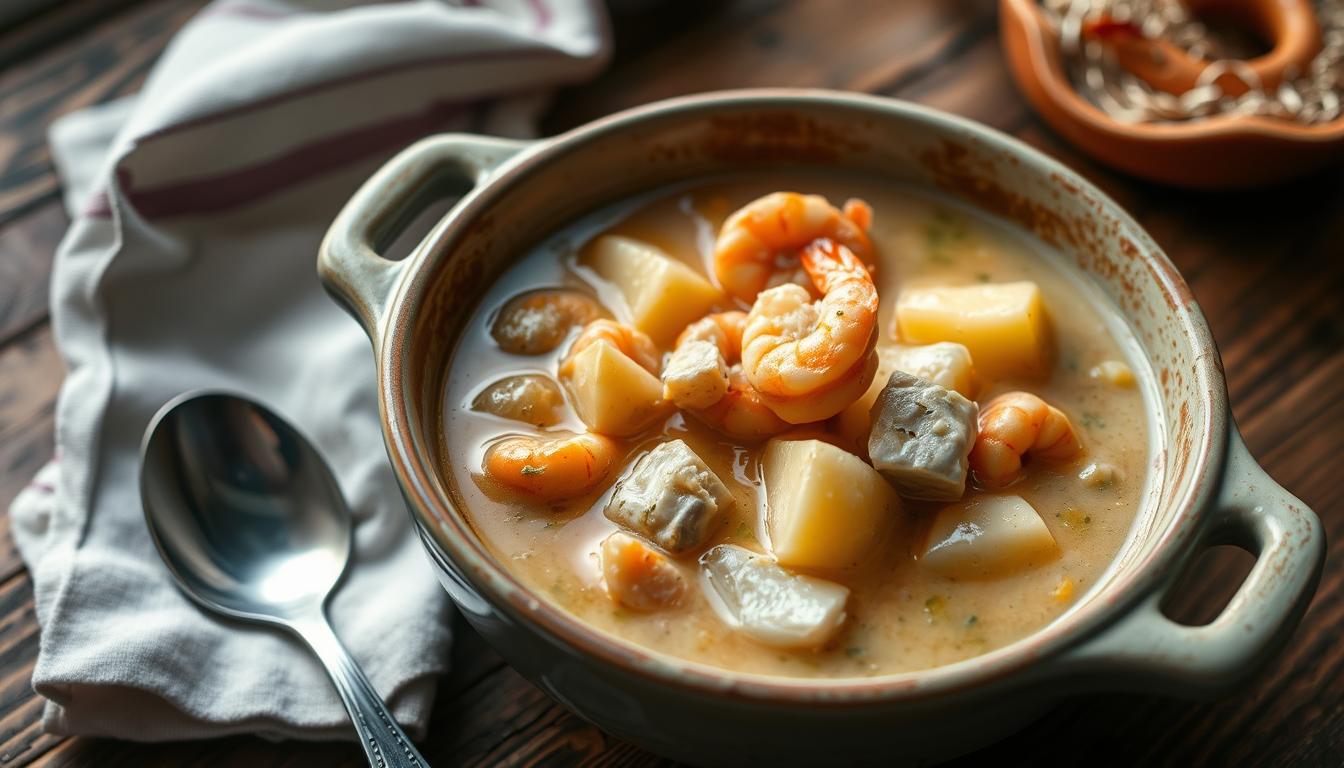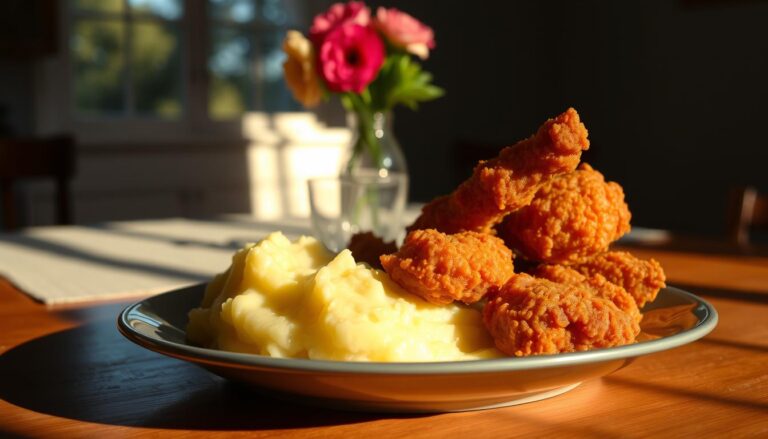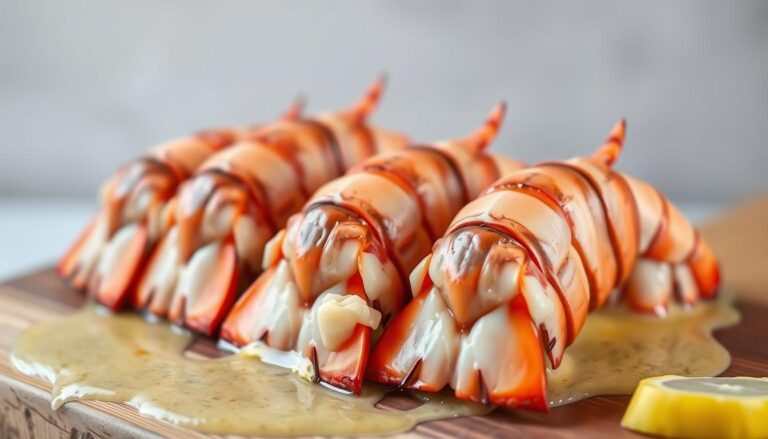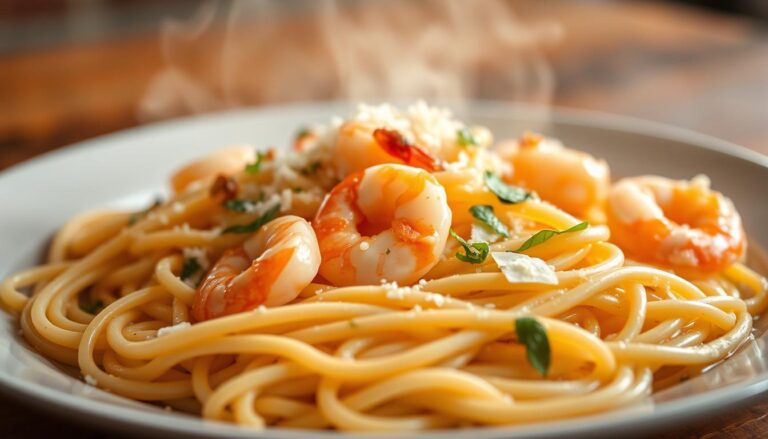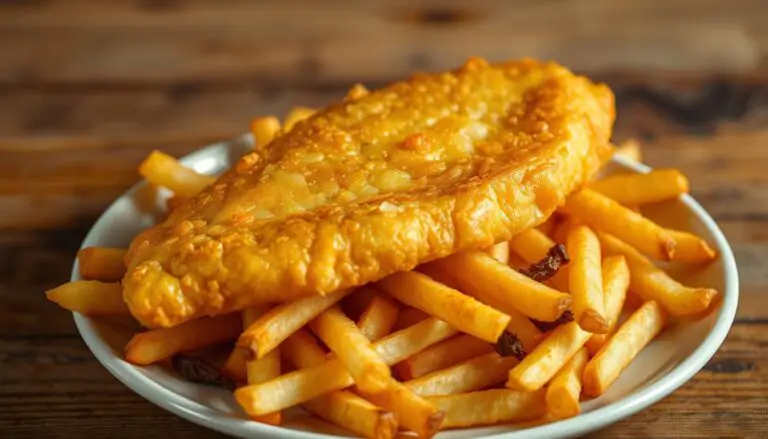As I reflect on my favorite comfort foods, a warm, creamy bowl of seafood chowder always comes to mind. It’s a dish that embodies the essence of a cozy evening, filled with succulent seafood and a rich, flavorful broth.
I recall the first time I savored a delicious seafood chowder; it was love at first taste. The combination of tender shrimp, flaky halibut, and juicy salmon chunks in a creamy base was nothing short of magical. Since then, I’ve been on a mission to recreate that experience, and I’m excited to share my Hearty Seafood Chowder Recipe with you.
This recipe is not just a meal; it’s an experience that brings together the freshness of the ocean and the warmth of a home-cooked meal. With a blend of seafood varieties and a creamy texture, it’s the perfect comfort food for any occasion.
Key Takeaways
- Discover a simple yet flavorful seafood chowder that’s perfect for any meal.
- Learn how to combine a variety of seafood for a rich and satisfying broth.
- Understand the versatility of this recipe and how it can be adapted to your preferences.
- Enjoy a nutritious meal that’s both comforting and delicious.
- Explore the benefits of using different types of seafood in your chowder.
My Journey with Seafood Chowder
My adventure with seafood chowder began in the picturesque landscapes of Alaska. During our last summer trip, we enjoyed some exceptional Alaskan seafood. A memorable dinner at the 49th State Brewing Company in Anchorage stood out, where my husband relished the King Crabby Grilled Cheese, served with Alaskan chowder for dipping.
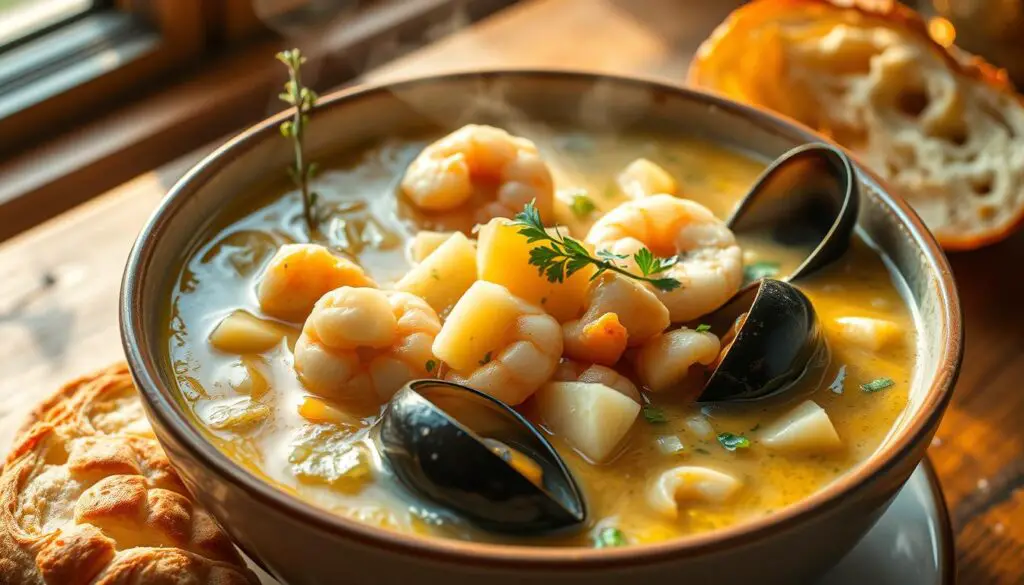
Inspiration from Alaska
The Alaskan chowder I tasted that evening was truly inspiring. Made with a rich blend of seafood, it set the standard for my own recipe. I was determined to recreate that flavor at home.
Why This Recipe Became a Family Favorite
After refining the recipe, our family fell in love with the comforting, rich taste of the chowder. It quickly became a family favorite. I’ve made adjustments over time, adding extra shrimp to enhance the flavor profile.
Why You’ll Love This Hearty Seafood Chowder Recipe
I have found that this seafood chowder recipe stands out due to its versatility and rich flavor profile. The combination of diverse seafood like shrimp, clams, and fish creates a symphony of flavors in every spoonful, making it a truly satisfying meal.
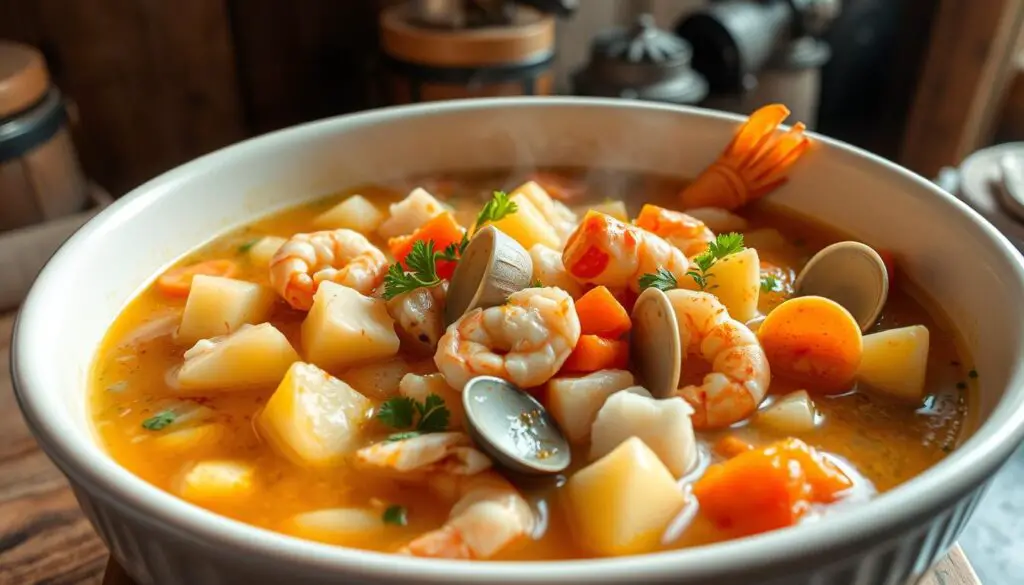
Rich and Flavorful Combination
The rich, creamy broth provides a comforting and hearty experience, perfect for cozy evenings. This seafood chowder recipe offers a perfect balance of tender seafood pieces and a flavorful broth.
Nutritional Benefits
Packed with high-quality protein and essential nutrients from various seafood, this chowder is not only delicious but also a healthy choice. The diverse seafood ingredients provide a range of nutritional benefits.
Versatility and Adaptability
This recipe is incredibly versatile, allowing you to adapt it based on seafood availability or personal preferences. You can customize it for different dietary needs while maintaining its delicious flavor profile.
- A symphony of flavors from different seafood varieties
- High-quality protein and essential nutrients
- Adaptable to personal tastes and seafood availability
Essential Ingredients for Perfect Seafood Chowder
Crafting the perfect seafood chowder requires a thoughtful selection of ingredients. The right combination of seafood, vegetables, and seasonings is crucial for a rich and flavorful chowder.
Seafood Selection
A diverse selection of seafood is essential for a hearty chowder. I use a mix of salmon, halibut, shrimp, and baby clams to create a rich flavor profile. The variety of fish and shellfish adds depth and texture to the chowder.
Base Ingredients
The base of the chowder is formed by sautéing vegetables like onions, celery, and carrots in butter. This mixture creates a flavorful foundation for the chowder. Additionally, potatoes are added to give the chowder a comforting, homely feel.
Herbs and Seasonings
To enhance the flavor of the chowder, I use a blend of herbs and spices, including basil, thyme, garlic, white pepper, and cayenne pepper. The cream adds a rich, velvety consistency that’s characteristic of a classic chowder. By balancing these ingredients, you can create a truly delicious seafood chowder.
Equipment You’ll Need
To get started with this hearty seafood chowder recipe, you’ll need some basic yet essential equipment.
The right equipment can significantly impact the outcome of your seafood chowder. A crucial piece of cookware is a heavy-bottomed pot, which allows for even heat distribution.
Cookware Essentials
A 4-quart pot is ideal for cooking the onion, celery, and carrots in butter over medium heat until the onions are translucent, about 5-7 minutes, thus optimizing your cook minutes. This size provides ample space for all ingredients.
Helpful Tools
In addition to a good pot, having a sharp knife for seafood preparation is vital. Other helpful tools include a wooden spoon for stirring and a ladle for serving.
Preparation Steps
To start making my hearty seafood chowder, the prep work is crucial. It involves several steps that ensure all ingredients are ready for cooking.
Preparing the Seafood
Cut the fish, such as salmon and halibut, into 1/2-inch chunks. Properly cleaning shrimp is also part of preparing the seafood. This step is essential for achieving uniform cooking.
Preparing the Vegetables
While the potatoes are boiling, use a 4-quart pot to cook the onion, celery, and carrots in butter over medium heat until the onions are translucent, about 5-7 minutes. This process softens the vegetables, enhancing the overall flavor of the chowder.
Step-by-Step Cooking Instructions
To create a truly exceptional seafood chowder, it’s essential to follow a series of carefully planned steps. This ensures that all the flavors meld together perfectly and that the seafood is cooked to perfection.
Creating the Flavor Base
The foundation of a great seafood chowder is its flavor base, which is created by sautéing onions, celery, and carrots in butter over medium heat until they’re translucent, about 5-7 minutes. This step is crucial as it lays the groundwork for the overall flavor of the chowder.
Making the Roux
Next, I stir in flour to make the roux, which thickens the broth and gives the chowder its signature consistency. Cooking the roux for 5 minutes ensures it’s lightly browned and fragrant, adding depth to the dish.
Adding Potatoes and Seasonings
After preparing the roux, I add diced potatoes, garlic, and a blend of herbs and seasonings to the pot. The potatoes absorb the flavors and add a satisfying texture to the chowder. Cooking the mixture over heat, stirring frequently, ensures that the flavors meld together.
Incorporating Seafood and Cream
Finally, I incorporate the seafood, including salmon, halibut, shrimp, and clam meat, into the chowder. Adding heavy cream towards the end of cooking gives the chowder a rich, velvety texture. Simmering the chowder for 10 minutes after adding the cream ensures that the flavors are fully incorporated and the seafood is cooked through.
Expert Tips for the Best Chowder
To elevate your seafood chowder game, it’s essential to master a few expert techniques that make all the difference. Crafting a truly exceptional chowder requires attention to detail and a few insider tips.
Achieving the Perfect Consistency
Maintaining a gentle simmer is crucial when cooking chowder. Boiling can break down the cream and make the seafood tough. To adjust the final thickness, thin it with a bit of fish stock or water if it’s too thick, or use a cornstarch slurry if it’s too thin.
Seafood Cooking Techniques
Proper seafood cooking techniques are crucial. Adding different types of seafood at different times ensures each cooks perfectly. Don’t overcook the seafood; add it towards the end of the cooking process, as the residual heat will continue to cook it.
Flavor Enhancement Secrets
To build layers of flavor in your soup, sauté the onions, celery, and carrots until they’re just translucent. Also, ensure the roux is cooked long enough to remove the raw flour taste but not so long that it darkens, altering the chowder‘s flavor and color.
Delicious Variations to Try
One of the best things about a great seafood chowder recipe is its versatility. You can easily modify it to suit different tastes and dietary preferences.
This adaptability makes it a perfect dish for various occasions, from casual family dinners to special events. Here are some exciting variations you can try:
Bacon Lover’s Seafood Chowder
Add a smoky twist to your chowder by incorporating crispy bacon bits. Simply cook the bacon separately until crispy, then sprinkle it on top of the chowder just before serving for a flavorful crunch.
Seafood Extravaganza Version
Transform your seafood chowder into an extravagant delight by adding premium ingredients like lobster and scallops. This medley creates a seafood feast in every spoonful.
Gluten-Free Adaptation
Make this chowder gluten-free by replacing all-purpose flour with a gluten-free flour blend for thickening. This adaptation caters to those with gluten sensitivities or preferences, ensuring everyone can enjoy the dish.
- Try substituting different types of fish like cod or haddock if halibut is hard to find.
- For a lighter flavor, use chicken broth instead of fish base and water.
- Enhance the flavor with a hint of garlic for added depth.
Serving Suggestions
The presentation of your seafood chowder can elevate the meal, making it a memorable experience for your guests. Serving it in a creative and appealing way can add to its charm.
Bread Bowl Presentation
One delightful way to serve your seafood chowder is in a bread bowl. To do this, purchase small, round French bread loaves, often referred to as “cannonball” bread. Hollow out the inside of the bread, leaving a shell that can be filled with the warm, savory chowder. This method not only adds a fun twist to the meal but also makes it more filling and satisfying.
Perfect Pairings
In the Maritimes, it’s traditional to serve seafood chowder with a soft dinner roll or tea biscuit on the side. However, you can also consider other accompaniments like crackers, a simple green salad, or even a sandwich to complement the flavors of this rich soup. For a complete meal, think about pairing it with other recipes that complement the flavors of the chowder. Some ideas include a fresh salad, roasted vegetables, or crusty bread for a satisfying and filling meal.
Storage and Reheating Instructions
Proper storage is crucial for maintaining the flavor and safety of seafood chowder. When stored correctly, it can be enjoyed over several days.
Refrigeration Guidelines
To store seafood chowder, place it in an airtight container and keep it in the refrigerator. This method prevents contamination and absorption of other odors. The chowder will remain good for up to 2-3 days when stored in this manner.
Reheating Methods
When reheating, gently warm the chowder on the stovetop over low heat, stirring occasionally. This method helps maintain the creamy texture and prevents the seafood from becoming tough. Avoid using a microwave, as it can heat unevenly and potentially spoil the delicate seafood. With time, the flavors of the chowder will meld together, often making it taste better on the second or third day.
Conclusion
After sharing this seafood chowder recipe, I’m excited for you to make it your own. This hearty chowder is worth the time and effort, becoming a treasured recipe in your collection. Experiment with different seafood combinations to make it perfect for any occasion.

